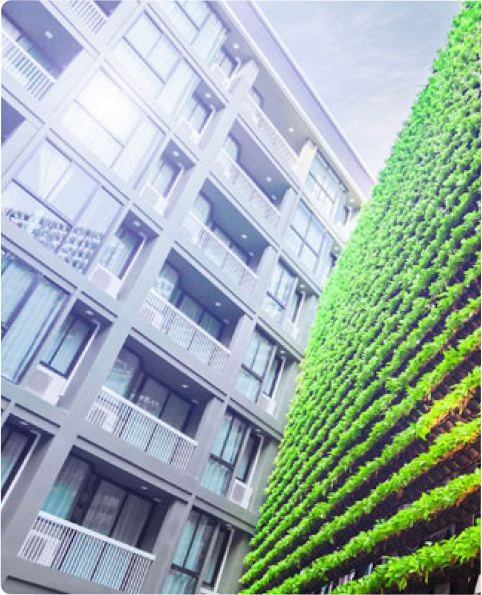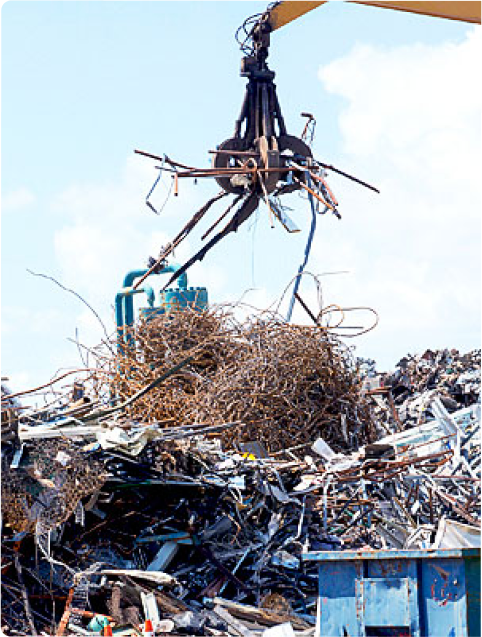Green Building & Sustainability
The purpose of Green Buildings is to improve public health, safety, and general welfare through enhanced design and construction of buildings, using concepts which reduce negative impact, and promote principles which have a positive environmental impact and encourage sustainable construction practices.
Submittal Requirements
The following types of projects are subject to the Los Angeles Green Building Code (LAGBC).
For building plans being submitted to Regular Plan Check, please provide an additional set of plans. This additional set of plans will be routed internally to the Green Building Section for plan check.
Approval from the Green Building Section will be required prior to the issuance of the Building Permit.
All new buildings (residential and non-residential)
All addition (residential and non-residential)
Alterations with building valuations of $200,000 or more (residential and nonresidential)
Residential alterations that increase the building's conditioned volume
Roof replacements of any value are subject to either LAGBC Section 4.106.5 (for residential projects) or LAGBC Section 5.106.13 (for nonresidential projects)
Building for a Better Tomorrow
The Los Angeles Green Building Code (LAGBC) is based on the California Green Building Standards Code (CALGreen) that was developed and mandated by the State to attain consistency among the various jurisdictions within the State, reduce the building's energy and water use, reduce waste, and reduce the carbon footprint.

Solar Energy
Production of electricity from fossil fuels creates pollution, including smog and greenhouse gas emissions. Combining the abundance of sunshine our city enjoys with the advantage of owning our own municipal utility, Los Angeles’s investment in solar is generating clean power, reducing pollution, and improving grid reliability.
Related Links

Water Conservation
In Los Angeles, we use an average of 104 gallons per day. Most of our water is used to irrigate our yards, keep our buildings cool, and fill our swimming pools. As drought conditions continue and Los Angeles looks to increase its own local water supply, long-term water conservation changes are needed at every level. New building codes and rebates provide incentives to conserve and adapt to a changing climate. For example, Angelenos can save thousands of gallons by installing water-efficient fixtures/appliances and drought-tolerant landscaping.
Related Links

Electric Vehicle Chargers
Transportation is one of the largest and fastest growing contributors to greenhouse gas emissions associated with climate change. The state of California has the highest ratio of car ownership in the world, while the transportation industry contributes more than 40% of statewide greenhouse gas emissions.
Electrical permits for Electrical Vehicle Charging Station(s) can be obtained using LADBS’s online permitting system.
Related Links

Existing Buildings Energy & Water Efficiency (EBEWE) Program
Per Division 97 of the Los Angeles Municipal Code (effective 2017), owners of certain existing buildings are required to: 1) Disclose their building’s energy and water consumption using the EPA's ENERGY STAR Portfolio Manager® system for benchmarking; and 2) Comply with the requirements for Audits and Retro-Commissioning. The City will use this information to generate various reports. For additional infomation, please see Related Links below for a full description of the Program.
Related Links

Cool Roof
A cool roof is a roofing product that reflects sunlight and absorbs less heat than traditional roofs. Cool roofs lower roof temperatures on hot sunny days and therefore keep buildings cooler inside, saving energy by reducing the need for running air conditioning systems. Although often light in color, cool roofs can come in a wide variety of colors ranging from white to black, including blues, grays, greens, oranges, browns, and tans. Cool roofs also are available in a variety of styles: shingle, shake, tile, membrane, and spray-on liquid coatings.
Related Links

Waste Hauling
On March 5, 2010, the Los Angeles City Council approved Council File 09-3029 pertaining to a Citywide Construction and Demolition (C & D) Waste Recycling Ordinance that requires ALL mixed C & D waste generated within city limits be taken to City-certified C & D waste processors. LA Sanitation (LASAN) is responsible for the C & D waste recycling policy.
Construction and demolition materials make up a large percent of the waste stream, but many of it can be reused or recycled. All haulers and contractors responsible for handling C & D waste must obtain a Private Waste Hauler Permit from LASAN prior to collecting, hauling and transporting C & D waste, and C & D waste can only be taken to City-certified C &D processing facilities.
Related Links
- List of Permitted Waste Haulers (pdf)
- Solid Waste Hauler/Contractor Permit Application (pdf)
- LA City Sanitation (Construction & Demolition Recycling under "What We Do: Recycling")

Fireplaces
The South Coast Air Basin presently has some of the highest levels of fine particulate pollution in the United States. Public health and air pollution concerns led to the adoption of Rule 445. Wood-burning devices are significant sources of air pollution in the Southland and can pollute indoor air with fine particulates and toxic air pollutants.
Related Links

All Electric
On May 20, 2025 the City Council passed Council Motion 22-0151, instructing the Department of Building and Safety to stay the enforcement of Ordinance No. 187714 (All Electric Buildings Ordinance). Therefore, effective immediately, the All-Electric Buildings Ordinance regulations shall no longer be required.
Related Links
